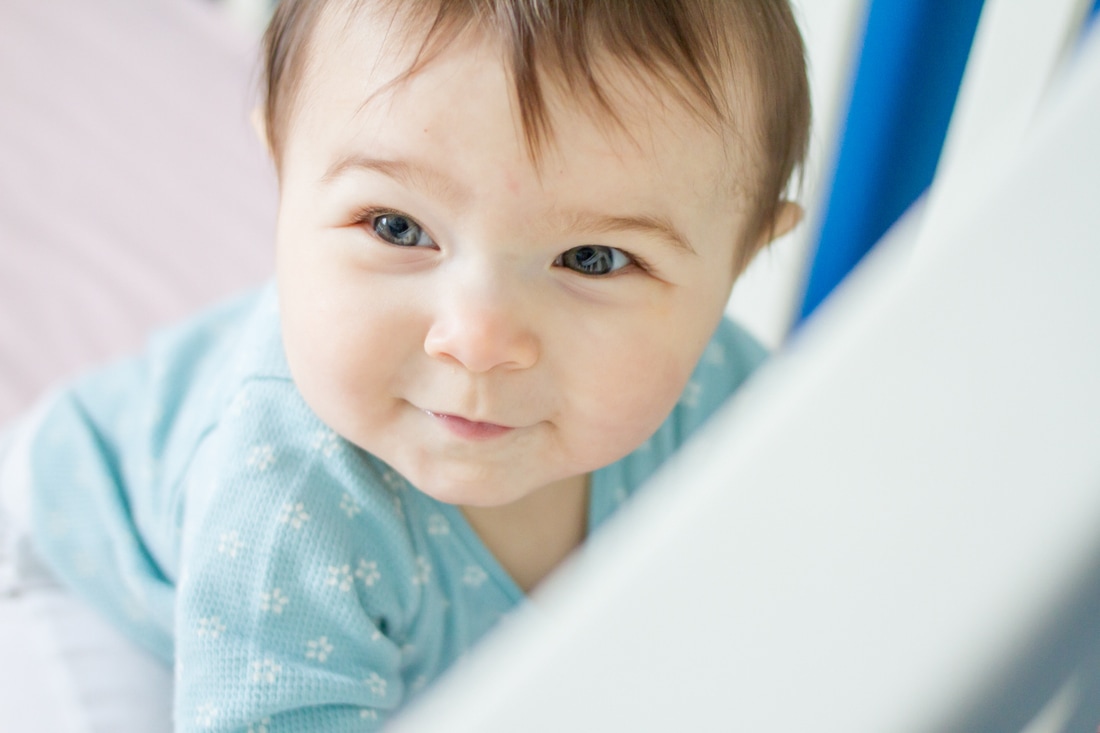|
Eight months was a time of transition for Piper. We moved her to her crib in her own room. After a few nights of watching on the monitor as she cried herself to sleep sitting up—hilarious—we had a night or two of okay sleep. We thought, "We've done it! She's a crib sleeper!" And then. Her first ear infection hit, and we've been spiraling downward on sleep ever since.
Piper has clearly entered the "full speed ahead" developmental phase; every new day brings new skills. Other than the constant string of colds and ear infections and not much sleep, life was pretty exciting at 8 months. She started to pull up on anything and everything. She was babbling up a storm and added "Mama" and "Dada" to her repertoire. She happily gobbled up her two little bowls of oatmeal and fruit puree each day. She began to crawl at unimaginable speeds, continued to play tricks to make us laugh and loved to grab contraband items like power cords and carbon monoxide detectors for attention. We can't get enough of her. Since it's probably unrealistic for you to hire a professional photographer to take monthly portraits of your baby, I'd like to use this session to demonstrate how you can take more meaningful photos yourself just by creating context. What I mean by creating context is deliberately using every aspect of action/activity, setting and wardrobe to capture complete moments. It may sound complicated, but it doesn't need to be. The baby sessions of my girls take a few minutes of planning and about 5-10 minutes of shooting. Here are six tips to help you create context for more memorable photos: 1. Identify a developmental milestone, activity or action that is representative of the month. What is something new the baby is doing? Is there a milestone this month that is fleeting, such as lying on her tummy and lifting a wobbly head? Since we created a crib non-sleeper this month, I wanted to capture Piper crawling around in her crib instead of sleeping in it. 2. Select a setting where this milestone, activity or action occurs. Here is where some of the artistry comes in. You want to find a place where the baby does this activity but that is bright and not too cluttered. If her favorite place to zoom around at full crawl is the dark basement playroom, think about her second or third favorite place. You need a lot of light to capture motion. Shooting outside will give you the most light. If you're inside and don't get a lot of light, consider opening an outside door and placing the baby in the light that streams in. Luckily Piper's room gets a lot of light. 3. Choose an outfit your child actually wears on a regular basis during this stage. In my favorite photos of my kids, they're wearing what I think of as their "uniforms" for that season—outfits they wear all the time that I want to remember them in. I don't buy fancy clothes for them for portraits that they don't wear regularly; I want the context to be accurate and meaningful. That said, you'll want to avoid clothing with cartoons or writing. Choose something you love to see them in that is simple, has some good texture and either coordinates well with the setting or gives a nice contrasting pop of color. For Piper's photos, I chose an outfit she wears just about every other day that I love and that also coordinates with her blueberry walls, white crib and pale pink sheets. I didn't want the outfit to distract or make the photos feel busy, but I wanted it to remind me of this phase. 4. Pick a time your baby is happy, and the light is bright. Photographers chase light, and you should too. But light is no good if it arrives at a time when the baby is fussy and uncooperative. Once you choose a location, keep an eye on the light in that space at different times of the day. Find a time that the space is filled with bright, indirect light and the baby is likely to be full of food, well rested and cooperative. Piper's room gets a lot of light, so I picked a time when the room would be bright but the light would be indirect, not glaring into the crib. We took these photos in the late morning when the light was right, and Piper had just woken up from a nap and eaten. 5. Prep the setting. You want your photos to represent the setting, but that doesn't mean it should be a mess. Even if you're typically buried in mounds of Legos and trains, you don't want the mess to overshadow the baby. Sure, if the activity you want to capture is the baby playing with a train, leave the train out. Just tuck away the extraneous clutter. We actually don't use Piper's room yet for much other than changing clothes and trying to convince her to sleep, so thankfully this corner didn't require tidying. 6. Take a variety of photos: close-up, pulled back, different angles, details. Creating context means not only shooting in a meaningful location, but also capturing important elements of that location so it's identifiable. If I had just taken close-ups of Piper's face, I'd never remember where she was when I looked at the photos a decade later. I wanted her to be able to see where she slept (or didn't sleep) when she was a baby. So I let her crawl around and pull up to her heart's delight while I got up close, walked all around the crib and crossed to the far side of the room. You can see the full crib and a bit of curtain in the most pulled back photo, and you can see the details of her eyes in the closest. (Make sure the eyes are in focus.) I used the crib bars to frame the shots in a variety of ways. Good luck using these tips to create more meaningful photos of your baby! Feel free to tag me on Instagram or Facebook to show me your portraits.
2 Comments
1/22/2024 03:03:53 am
Click On The Given Link To Read More Such Post.
Reply
Leave a Reply. |
My new book is out! Click to learn more about it.Hello thereI'm Julia Soplop, writer and photographer. I believe there is something profound in bearing witness to moments of joy and pain in others’ lives. My husband, three girls and I live outside of Chapel Hill, NC. You can read more about me here.
Snag my new photo curriculum for kids!Categories
All
Popular posts |























